1. Purpose of works
In September 2007, an exceptional event occurred that was unique in terms of its extent, required speed, as well as the number of workers and the technology involved. It concerned an intervention at the DN 500 Družba crude oil pipeline in the Klobouky – Moutnice section, which consisted in replacing 32 pipes whose parameters, as determined through an internal inspection, did not meet those required to ensure the future secure operation of the pipeline. These pipes were improperly installed in two locations within about 8 km of the crude oil pipeline, not far from the Klobouky pumping station (PS).
It was necessary to replace the aforementioned number of pipes within just 96 hours of pipeline shutdown. This required a great deployment of capacities to all the work assignments – clearing out the crude oil from the pipes, ensuring a safe environment for welding, assembling the works for cutting out the pipes, installing pipes back into the pipeline, and non-destructive testing (NDT) of the welds. It was necessary to select the most optimal work flow for the entire project, choose reliable contractors for the assembly works, prepare the entire project in technical and organisational terms, and coordinate the activities of the large number of sub-contractors within a relatively small space.
To execute replacement of the 32 DN 500 pipes in 96 hours, it was necessary to first expel the crude oil from all pipes intended for replacement and then to ensure a safe atmosphere inside the pipes for performing the welding-assembly works. For these reasons, it was decided to push out the crude oil from the entire section containing unsuitable pipes (the section was ca 9.7 km long) and subsequently to decontaminate the emptied section of the pipeline.
The time for emptying the pipeline was limited, and machinery needed to push the crude oil out to the next section of the crude oil pipeline (compressors with pressure of 35 bars and flow quantity of at least 15,000 m3/hour) is not available in the Czech Republic – and neither is it probably elsewhere in Europe. Therefore, it was decided to empty in advance an appropriate section of the Rajhrad – Velká Bíteš DN 700 pipeline in the section from the Rajhrad terminal equipment (TE) to the Ořechov gate chamber (GC) and then to push out the crude oil from the Klobouky PS – Moutnice GC section into this emptied section during the pipeline’s shutdown. After consultations with the operator, it was decided that the crude oil in this section in the volume of ca 2,500 m3 would be carried out in tank trucks to the pumping stations in Klobouky and Velká Bíteš.
Workflow during the aforementioned activities was organised as follows:
- Preparation works before shutdown:
- emptying the Rajhrad – Velká Bíteš DN 700 crude oil pipeline in the section from the Rajhrad terminal equipment (TE) to the Ořechov GC (thereby creating storage capacity),
- preparing worksites for replacing pipes (marking out the pipes to be replaced, ground works, locating and verifying the pipes to be replaced, NDT selection of points for cuts, installing TOR inlets, distributing new pipes).
- After the start of shutdown:
- emptying the DN 500 pipeline in the PS Klobouky – GC Moutnice section in the length of ca 11 km,
- decontaminating the DN 500 pipeline in the PS Klobouky – pipe no. 974 section (last unsuitable pipe from PS Klobouky) in the length of 9.6 km,
- replacing 32 unsuitable pipes by cutting them out and installing new pipes.
Due to the fact that the section with the pipes to be replaced was not far from PS Klobouky, a terminal chamber was used to push out the crude oil from the PS Klobouky – GC Moutnice section. If this chamber had not been nearby, it would have been necessary to separate the pipeline in another way, for example, using STOPPLE technology.
2. Emptying the Rajhrad – Velká Bíteš DN 700 pipeline in the Rajhrad – Ořechov section
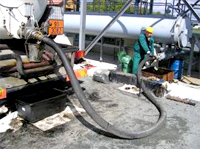
The Rajhrad – Velká Bíteš DN 700 pipeline in the Rajhrad – Ořechov section was emptied in advance in order to be able to transfer the crude oil from the DN 500 Klobouky PS – Moutnice GC section to the emptied pipe during the shutdown.
The crude oil from the aforementioned section of the DN 700 pipeline was pushed out, using an air-driven multi-plate piston, from Ořechov GC towards the Rajhrad terminal equipment, where the oil was discharged into tank trucks (see Figure 1). Then the crude oil was carried to the pumping stations in Klobouky and Velká Bíteš, where it was gradually re-pumped through the slop tanks back to the DN 500 pipeline. The volume of the crude oil discharged from the section was ca 2,450 m3, and the time to transfer the entire volume was 5 days, using 8 CAS tank trucks with volumes of 10 and 30 m3.
While emptying the DN 700 pipeline, stringent environmental measures were taken to prevent contamination of the environment. All minor spills and created waste were immediately removed in an environmentally sound way.
3. Preparing worksites for replacing pipes
Based on data from the internal inspection reports of the unsuitable pipes, the pipes were located and then uncovered. Afterwards, the welds on the pipes were located and their insulation was removed. Subsequently, it was verified whether or not the uncovered pipes were actually those intended for replacement. First the pipe length was measured (the distance between the welds), and then an ultrasound technique was used to measure the thickness of the walls for both the pipes to be replaced and the adjacent pipes. The measured values were compared with the reports. The last test consisted in comparing the position and the external length of the spiral welds on the adjacent pipes with the data in the report. Afterwards, the pipes to be replaced were uncovered along their entire lengths and working excavations were made at the points of the welds. When uncovering the pipes, it was discovered that the parallel pipes of the DN 200 product pipeline were at several points laid in close proximity to the DN 500 crude oil pipeline, sometimes with a spacing of only 10 cm (see Figures 2 and 3).
On the existing pipeline, the points for future welds of the pipes to be installed were selected using ultrasound (UT) and magnetic (MT) tests, and the quality of the production welds was assessed. The mentioned tests discovered several objectionable defects (laminations, mill defects, cracks). The points where defects were discovered were indicated, and the lengths of the parts of the pipeline to be replaced were extended accordingly.
Eight TOR 2 inlets had been installed onto the crude oil pipeline during its operation and were used to identify the position of the pigs and for controlling the condition inside the cleaned pipe.
The distribution of the new pipes (welded pipes 530 x 8.00 mm, material L 360 MB, with asphalt insulation, produced by Mittal Steel Ostrava) was made more difficult due to the terrain, which, due to heavy raining at that time, was sometimes impassable for wheeled machinery.
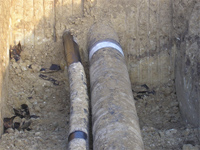
4. Emptying the DN 500 pipeline in the Klobouky – Moutnice section
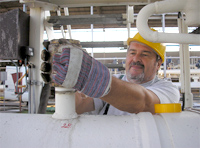
The DN 500 Družba pipeline in the Klobouky PS – Moutnice GC section was emptied using a set of multi-plate pistons. A fixed amount of water serving as an inert plug was pumped between the pistons.
The set of pistons and water plugs inserted into the terminal chamber of the DN 500 crude oil pipeline in the area of Klobouky PS was moved using compressed air towards Moutnice GC, while pushing out the crude oil from the pipeline. The crude oil was moved through the DN 500 pipeline towards Rajhrad GC, where it was discharged through the DN 500 connection pipe to an emptied section of the DN 700 Rajhrad TE – Ořechov GC pipeline.
5. Decontaminating the DN 500 pipeline in the Klobouky – pipe no. 974 section
After pushing out the crude oil from the Klobouky PS – Moutnice GC section ca 1 km past the last planned cut-out (pipe no. 974), the unsuitable part of the pipe was cut out using a sparkless method. The pipe was taken out from the pipeline and secured against spilling the residual crude oil.
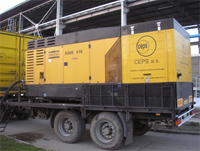
After cutting out this pipe, it was established that the crude oil was reliably removed from the pipeline and that the film of residual crude oil on the internal surface of the pipes was very thin. Nevertheless, there continued to be an explosive atmosphere within the pipeline that prohibited working with open fire.
Both ends of the pipeline were manually cleared of residual crude oil. The crude oil pipeline towards Velká Bíteš was hermetically closed by inserting a separating sealing piston into the pipeline. In the pipeline directed to Klobouky, a clay plug was installed and, after ensuring a safe atmosphere, a special cleaning chamber with cleaning pistons was welded onto the pipeline.
The aforementioned works were performed under strict fire-protection and environmental safety controls. All minor spills and created waste were immediately removed in an environmentally sound way.
A precisely determined amount of a solution with Petrosol decontamination agent in a range of several precisely defined concentrations was gradually pumped in between the pistons into the special cleaning chamber, as well as the control plug of cleaning water. Afterwards, this set of pistons and cleaning plugs was moved to Klobouky PS in a controlled way using compressed air. The speed of the cleaning set was determined based upon calculations of how quickly residual crude oil would pass into the Petrosol solutions at various concentrations.
After the entire cleaning set had reached the Klobouky PS, the used decontaminating solution was pushed out into tank trucks and taken for ecological disposal through biodegradation.
After pushing out the decontaminating solution, the crude oil pipeline was depressurised, and the concentration of explosive gases was measured through the 3 TOR 2 access openings, which had been pre-installed on the pipe for that purpose. After fully depressurising the pipe, the concentration of explosive gases was measured again through these access openings. The measurement verified that the content of explosive gases in the pipe was far below the lower explosion limit, and, therefore, it was possible to make the cut-outs using an oxyacetylene flame.
For each of the cut-outs made subsequently, it was confirmed that through the decontamination the crude oil residuals had been fully removed from the internal surfaces of the pipe. The surfaces were clean, without grease or crude oil deposits (see Figure 6).

6. Replacement of unsuitable pipes by cutting out and installing new pipes
The replacement of 32 pipes in 96 hours comprised a large volume of work involving a great number of workers and machinery. On 19 and 20 September 2007, nearly 100 workers from 14 companies participated in the works.
To replace the pipes, the main contractor, CEPS a.s., chose partner companies that could be reasonably anticipated to perform the welding and assembly works in the required quality even in a very short time. Partners were chosen whose quality management systems were certified according to ISO 9001. Some of the companies also hold certificates under ISO 14 0001 (environmental protection) and OHSAS 18001 (occupational safety). All companies have long experience in performing construction and assembly works on the Družba crude oil pipeline or on high-pressure gas pipelines and are certified in the GAS company system for assembly works on high-pressure gas pipelines.
The individual suppliers of assembly works assigned to the project a total of 16 fully equipped work groups. The intensity of the work groups’ placement is illustrated in Figure 9. The same quality requirements were also applied to the NDT works. The company Qualitest, s.r.o. was selected to do these works, as it has extensive experience in the field of NDR for long-distance pipelines and also holds an ISO 9001 certificate. Eight work groups, including 5 mobile laboratories, were involved in these works.
The access to certain worksites, especially to a majority of worksites in section 1, was quite difficult due to the soggy terrain. Four worksites in location 2 were in a rather steep gorge.
Because the decontamination of the pipes ensured a non-explosive and non-flammable environment in all pipes (except pipe no. 974), it was possible to use flame-cutting on the pipes, which considerably sped up the works. The pipe cut-outs were mostly made using an oxyacetylene torch, or exceptionally using a sparkless technique (only in order to remove the pipe more easily from the pipeline).
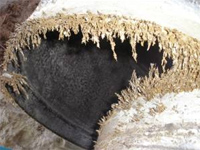
It was discovered already in cutting out the pipes that the pipeline is very strongly magnetised. The intensity of the magnetic field was so strong that even objects with the weight of a hammer would stick to the pipe. Figure 7 shows the magnetisation of the pipe after cutting it out with a grinder. This strong magnetisation made welding much more difficult, and not only did it extend the time period for welding the connections but also caused several defects in the welds.

Welding of the new pipes was done in accordance with requirements of the standard CSN EN 12 732 – with welding supervision. In accordance with the WPS of individual assembly companies, WPS was approved by means of WPQR or WPAR.
It was necessary to minimise the influence of the strongly magnetised pipe during the welding works, especially by creating a second, compensating magnetic field. That was accomplished by looping welding conductors around the pipe (see Figure 8).
Pipe no. 974, for which a non-explosive environment was not ensured during the decontamination of the pipeline (the sealing piston was inserted into the adjacent pipe no. 975, and the free part was only washed by hand), was among the last to be installed. Before starting the works related to inserting the pipe, it was verified whether or not the atmosphere was safe for welding, that the position of the sealing piston had not changed since its insertion, and that the sealing head was tightly sealed with the clay plug. Insertion of the pipe was safeguarded in both fire-protection and environmental terms. The pipe nearest to the Klobouky PS (no. 118) was inserted in a similar way.
After welding the peripheral connections of the inserted pipes, the following NDT tests were performed:
- visual test (VT) of the welds according to CSN EN 970,
- magnetic test (MT) according to CSN EN 1290, and
- radiation test according to CSN EN 1435.
Several defects that occurred in the welds were removed by grinding and subsequent re-welding in accordance with the respective WPS.
In all cases, the defects were corrected by the first repair.
Emptying and decontamination of the DN 500 crude oil pipeline and the subsequent welding and assembly works, including NDT weld tests, were completed in 87.5 hours from the start of the shutdown.
From that time, the crude oil pipeline was ready to be put back into operation.
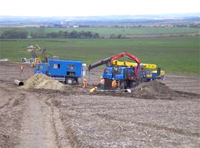
7. Time schedule of the executed works
Time schedule of the works during the crude oil pipeline shutdown:
- 17.9. at 6:00, starting to push out the crude oil.
- 17.9. at 9:00, crude oil pushed out beyond the point of the last cut-out.
- 17.9. at 9:45, pushing out of ca 2,400 m3 of crude oil completed, starting to release the pressurised air.
- 17.9. at 12:00, releasing of air finished.
- 17.9. from 12:00 to 19:00, cutting out a part of pipe no. 974, welding the special cleaning chamber.
- 17.9. from 19:00 until 23:00, Petrosol decontaminating agent taken and pumped into the pipe.
- 17.9. from 23:00. until 10:30 of the following day, decontaminating 9.7 km of the DN 500 pipe.
- 18.9. from 10:45 until 17:45, Petrosol decontaminating agent pumped from the pipe into tank trucks and taken to ecological disposal.
- 18.9. from 17:45 until 18:30, depressurising the decontaminated part of the DN 500 pipe.
- 18.9. at 18:30, performing first cut-out of the pipe using an oxyacetylene flame.
- 18.9. at 20:00, another 5 cut-outs of the pipe made.
- 19.9. at 20:00, all 32 pipes intended for replacement cut out, 16 pipes inserted.
- 20.9. at 21:30 NDT test of the last inserted pipe completed. The pipe was ready to be put back into operation after 87.5 hours of work.
8. Conclusion
The approximately 87.5 hours of non-stop work involved:
- pushing out the crude oil from more than 9.66 km of the DN 500 crude oil pipeline,
- decontaminating 9.66 km of the DN 500 crude oil pipeline, and
- making 32 cut-outs then inserting pipes into the DN 500 crude oil pipeline, including NDT.
Participating in execution of the works under the CEPS contract were these partners: 1.SPZ, s.r.o.; Glumbík, s.r.o.; Kosogass – inženýring, s.r.o.; Moravský Plynostav, a.s.; STP Special services, s.r.o.; Streicher, s.r.o.; Qualitest, s.r.o.; Technotest, s.r.o.; Limek Plus, s.r.o.; Baufeld, s.r.o.; HG stav, s.r.o.; HZS ČEPRO, a.s.; and Acstroje s.r.o.